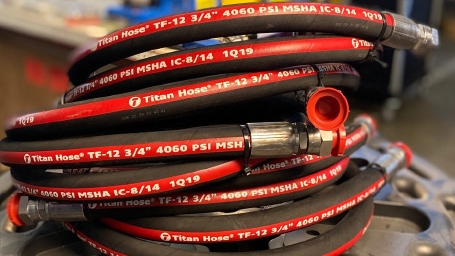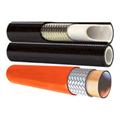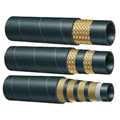Hydraulic Hose

- Application – What kind of an application?
- Size – What is the inner and outer diameter? What is the required length?
- Pressure – What is the exerted system pressure?
- Temperature What are the liquid or fluid and surrounding temperatures?
- Material to be conveyed – What is kind of material is transferred? Is it compatible with the tube of the hose?
- Ends or Couplings – What are the other parts or hydraulic fittings required?
- Delivery – What is the delivery time and place?
Important Facts:

- Hydraulic hoses and hose assemblies are made of different materials to be used in different applications such as
 Hydraulic hoses usually consist of three parts including
Hydraulic hoses usually consist of three parts including- The hose is better than a tube because it provides better resistance to corrosion and heat. It is more flexible and can be easily fabricated. It is available in longer lengths, easy to install in small areas, and heat resistant.
- Hose durability is dependent on several characteristics such as temperature, environment, application, pressure, etc.
- The inner diameter of the hose is also called "Dash Size."
- The spiral hose is considered stronger and suitable for high-pressure applications as compared to a braided hose.
- Waste and dirt in a hydraulic system can damage the hose very quickly so in order to make it last longer oil and filter need to be changed regularly.
-
Elastomeric or rubber hoses are extremely flexible and recommended for low as well as high pressure applications.
-
Fluoropolymer hose is considered suitable for transmission of harsh chemicals and better corrosion resistance as well as high temperature applications.
-
Thermoplastic hoses are considered suitable when the main concern is kink resistance.
-
Metal hoses are recommended for high temperature material transmission as well as ultra-high pressures. They are either flexible or hard.
-
The inner tube is usually flexible and allows the smooth transfer of the liquid or fluid it carries.
-
The reinforcement layer is a braided or spiral wire of fabric or metal. The braided wire is a crisscross pattern that allows flexibility and the spiral wires are parallel to each other wound around the hose.
-
The outer layer is weather or abrasion-resistant. It is designed to tolerate adverse environmental conditions. It is a cover for the hose.
Types of Hydraulic Hoses
There are several standards that any type of hydraulic hose is required to meet in order to be considered suitable for high-pressure applications, and twisted hose assemblies. A standard hose is not considered suitable for hydraulic systems. Hydraulic hoses are used for high-pressure applications either on mobile or fixed machinery. They are used by oil & gas drilling companies, for mining or construction purposes, waste or recycling purposes, power generation, and repair and maintenance.
Hydraulic hoses are required to withstand an average internal pressure of 3000 psi and extremely high temperatures.
There are standards developed by SAE, the engineering organizations for manufacturing of the hoses in order to ensure efficient and effective operation, and human safety and security. There are standards that provide general requirements as to the dimensions and performance of hydraulic hoses that are to be used in mobile or fixed machinery.
The hose consists of three layers as mentioned above; the inner layer must be flexible and should be able to withstand the pressure and high temperature of the fluid. It is usually made of synthetic rubber or PTFE or thermoplastic material. The reinforcement layer is a fabric wired around to allow flexibility and resist high pressure in the hydraulic systems and the outermost layer is like a cover that protects the hose from external environmental damage and abrasion. It is also very important to consider hose fittings, their size, and whether the hydraulic fittings will be able to resist the pressure and temperature to which they are exposed.
The five most common types of hydraulic hoses that are used for different purposes are listed below:
1. SAE Standard Hose:

SAE 100R2 -S is a high-pressure hose that is used for petroleum or fluids having a water base. The reinforcement layer has two high tensile steel wire braids and the outer cover is abrasion, ozone, and weather resistant synthetic rubber, which is MSHA approved. The temperature ranges from -40F to +212F (+248F max.)
2. Standard High-Pressure Hose:

This type of hose is flexible and is commonly used for transmitting mineral oils as well as water-oil blends. They are highly in demand by construction, mining and oil refining industries, and agricultural purposes.
3. Low-Pressure Hose:

This type of hose is highly flexible and is used in lighter applications, for instance, return lines, lube lines, etc. The reinforcement layer usually consists of two synthetic textile braids and the outer cover is abrasion, ozone, and weather resistant synthetic rubber, which is MSHA approved. The temperature resistance ranges from -40F to +212F.
4. Steel Wire-Braided Hose:

It is available either in a single or double braided steel wire. It is durable and is suitable to be used in extremely high pressure or high-temperature applications. The double braided steel wire hose is also known as a hydraulic jack hose.
5. Stainless Steel PTFE Hose:

They are used by oil & gas drilling companies, for mining or construction purposes, for waste or recycling purposes, power generation, and repair and maintenance. The reinforcement layer is one braid of high tensile stainless steel braided wire and the tube is an extruded white PTFE. The temperature resistance ranges from -65F to +450F.